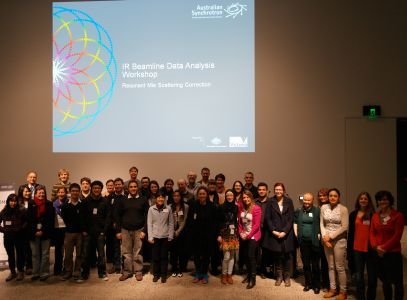More than 40 researchers and potential new users of synchrotron infrared microspectroscopy techniques attended a data analysis workshop at the AS in June 2012.
 The workshop introduced participants to the use of resonant Mie scattering (RMieS) corrections to remove baseline distortions in Fourier transform IR spectra from biological single cells and tissue sections. Mie scattering has long been a barrier to the advancement of IR microspectroscopy in biological research, but recently-developed correction algorithms have opened up new horizons in analytical interpretations.
The workshop introduced participants to the use of resonant Mie scattering (RMieS) corrections to remove baseline distortions in Fourier transform IR spectra from biological single cells and tissue sections. Mie scattering has long been a barrier to the advancement of IR microspectroscopy in biological research, but recently-developed correction algorithms have opened up new horizons in analytical interpretations.
The keynote speaker was Paul Bassan from the University of Manchester, co-developer of a powerful RMieS correction algorithm based on extended multiplicative signal correction (EMSC). Paul explained that the anomalous dispersion artefact often observed in IR spectra of biological samples is primarily due to resonant Mie scattering, and presented a method of reducing this model into an EMSC problem using principal component analysis (PCA).
Other presenters included Wojtek Goscinski (Monash University), who spoke about the MASSIVE (Multi-modal Australian ScienceS Imaging and Visualisation Environment) high-performance computing cluster at the AS and Monash University. Keith Bambery, who recently joined the AS from Monash University, explained how to use MASSIVE to perform RMieS corrections on synchrotron FTIR data. MASSIVE can compute RMieS corrections 60 to 100 times faster than a high-end desktop PC.
Andrew Bales from Bruker Optics introduced the new OPUS 7.0 software, and Michael D’Silva from VeRSI (Victorian eResearch Strategic Initiative) and Mark Tobin (AS principal infrared scientist) demonstrated how to use RAIDAR (Remote Access to Infrared Data Analysis Resource), which enables researchers to remotely analyse their IR beamline data.

The second day consisted of hands-on tutorial sessions led by Keith in which participants used MASSIVE to compute RMieS corrections to examples of FTIR spectra from the AS IR microspectroscopy beamline. Some people worked on their own data from the beamline. Attendees received user accounts for MASSIVE and had the RMieS-EMSC software installed on their laptops.
The workshop was the third in a series organised by IR beamline scientist Ljiljana Puskar. Earlier workshops in 2010 and 2011 focussed on multivariate statistical analysis using CAMO The Unscrambler software. The 2012 workshop was sponsored by MASSIVE, VeRSI, Bruker Optics and the AS.
Workshop participants said they particularly enjoyed Paul Bassan’s involvement, their interactions with beamline scientists and other researchers doing similar work, and the hands-on experience in performing RMieS-EMSC via MASSIVE.
Mark Tobin, who heads the IR beamline team at the AS, said the team was grateful to Rebecca Schepers (AS External Relations) and AS User Office staff for their assistance with workshop organisation.
Information on performing RMieS-EMSC corrections using MASSIVE is available on the AS website, mainly for Australian and New Zealand users, who have access to MASSIVE. Visit <archive.synchrotron.org.au/index.php/aussyncbeamlines/infrared-micro/data-analysis> for more information. AS staff can also offer advice to international colleagues and collaborators interested in adapting RMieS-EMSC to cluster computing systems similar to MASSIVE. Contact Keith Bambery at [email protected] or [email protected]
Photos
Above right: Participants in the infrared beamline data analysis workshop at the AS in June 2012
Above left: The workshop’s hands-on sessions enabled participants to apply RMieS corrections to their own data or sample spectra from the IR microspectroscopy beamline
